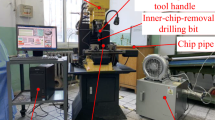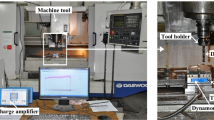Abstract
In the drilling process of multilayer printed circuit boards (PCB), drill wear will reduce the stability of the drilling process and affect the processing efficiency and drilling quality, so the prediction of drilling force and the monitoring of drill wear status during the drilling process are particularly important. A spindle current-based drilling force prediction and drill wear monitoring technique with theoretical models of drilling force, drill wear, and current signal is investigated to realize a feasible and low-cost online monitoring system for PCB drilling process. The prediction and monitoring technique consists of a semi-empirical theoretical model of the drilling force and torque considering drilling parameters and drill wear as well as a theoretical model between drilling torque and spindle current. The coefficients in the theoretical models were determined by measuring drilling force and spindle current signals through the drilling experiments with variable parameters and drill wear. The experimental results show that the relative errors between the predicted and experimental results of spindle current increment with variable drilling parameters and wear amounts are basically less than 10% and the prediction accuracy of the drilling force model is good when the drill flank is worn in the early and middle stages, which shows that the proposed spindle current-based drilling force prediction and drill wear monitoring technique has high prediction accuracy as well as strong effectiveness.














Similar content being viewed by others
Data availability
The datasets used or analyzed during the current study are available from the corresponding author or the first author on reasonable request.
Code availability
The code used during the current study is available from the corresponding author or the first author on reasonable request.
References
Koklu U, Morkavuk S, Urtekin L (2019) Effects of the drill flute number on drilling of a casted AZ91 magnesium alloy. Materials Testing 61(3):260–266. https://doi.org/10.3139/120.111315
Coban H, Koklu U (2022) Drilling of AZ31 magnesium alloy under dry and cryogenic conditions. J Mater Manuf 1(1):7–13. https://doi.org/10.5281/zenodo.7107296
Gill SK, Gupta M, Satsangi PS (2013) Prediction of cutting forces in machining of unidirectional glass fiber reinforced plastics composite. Front Mech Eng 8:187–200. https://doi.org/10.1007/s11465-013-0262-x
Pirtini M, Lazoglu I (2005) Forces and hole quality in drilling. Int J Mach Tools Manuf 45:1271–1281. https://doi.org/10.1016/j.ijmachtools.2005.01.004
Rao GVG, Mahajan P, Bhatnagar N (2007) Micro-mechanical modeling of machining of FRP composites – Cutting force analysis. Compos Sci Technol 67:579–593. https://doi.org/10.1016/j.compscitech.2006.08.010
Langella A, Nele L, Maio A (2005) A torque and thrust prediction model for drilling of composite materials. Compos A Appl Sci Manuf 36:83–93. https://doi.org/10.1016/j.compositesa.2004.06.024
Matsumura T, Tamura S (2013) Cutting force model in drilling of multi-layered materials. Procedia CIRP 8:182–187. https://doi.org/10.1016/j.procir.2013.06.086
Anand RS, Patra K (2017) Mechanistic cutting force modelling for micro-drilling of CFRP composite laminates. CIRP J Manuf Sci Technol 16:55–63. https://doi.org/10.1016/j.cirpj.2016.07.002
Abdul Nasir AA, Azmi AI, Lih TC, Abdul Majid MS (2019) Critical thrust force and critical feed rate in drilling flax fibre composites: a comparative study of various thrust force models. Compos B Eng 165:222–232. https://doi.org/10.1016/j.compositesb.2018.11.134
Saoudi J, Zitoune R, Mezlini S, Gururaja S, Seitier P (2016) Critical thrust force predictions during drilling: analytical modeling and X-ray tomography quantification. Compos Struct 153:886–894. https://doi.org/10.1016/j.compstruct.2016.07.015
Okutan E, Karabay S, Sınmazçelik T, Avcu E (2013) A study on the derivation of parametric cutting force equations in drilling of GFRP composites. Strojniški vestnik J Mech Eng 59:97–105. https://doi.org/10.5545/sv-jme.2012.774
Sun W, Yeh S (2018) Using the machine vision method to develop an on-machine insert condition monitoring system for computer numerical control turning machine tools. Materials 11:1977. https://doi.org/10.3390/ma11101977
Dai Y, Zhu K (2018) A machine vision system for micro-milling tool condition monitoring. Precis Eng 52:183–191. https://doi.org/10.1016/j.precisioneng.2017.12.006
Yu X, Lin X, Dai Y, Zhu K (2017) Image edge detection based tool condition monitoring with morphological component analysis. ISA Trans 69:315–322. https://doi.org/10.1016/j.isatra.2017.03.024
Zhu K, Liu T (2018) Online tool wear monitoring via hidden semi-Markov model with dependent durations. IEEE Trans Industr Inf 14:69–78. https://doi.org/10.1109/TII.2017.2723943
Zhang X, Yu T, Wang W (2018) Prediction of cutting forces and instantaneous tool deflection in micro end milling by considering tool run-out. Int J Mech Sci 136:124–133. https://doi.org/10.1016/j.ijmecsci.2017.12.019
Li X, Ouyang G, Liang Z (2008) Complexity measure of motor current signals for tool flute breakage detection in end milling. Int J Mach Tools Manuf 48:371–379. https://doi.org/10.1016/j.ijmachtools.2007.09.008
Lin X, Zhou B, Zhu L (2017) Sequential spindle current-based tool condition monitoring with support vector classifier for milling process. Int J Adv Manuf Tech 92:3319–3328. https://doi.org/10.1007/s00170-017-0396-9
Cao K, Han J, Xu L, Shi T, Liao G, Liu Z (2022) Real-time tool condition monitoring method based on in situ temperature measurement and artificial neural network in turning. Front Mech Eng 17(1):5. https://doi.org/10.1007/s11465-021-0661-3
Gomes MC, Brito LC, Bacci Da Silva M, Viana Duarte MA (2021) Tool wear monitoring in micromilling using Support Vector Machine with vibration and sound sensors. Precis Eng 67:137–151. https://doi.org/10.1016/j.precisioneng.2020.09.025
Arunkumar N, Thanikasalam A, Sankaranarayanan V, Senthilkumar E (2018) Parametric optimization of deep-hole drilling on AISI 1045 steel and online tool condition monitoring using an accelerometer. Mater Manuf Processes 33:1751–1764. https://doi.org/10.1080/10426914.2018.1476757
Lee SH, Lee D (2008) In-process monitoring of drilling burr formation using acoustic emission and a wavelet-based artificial neural network. Int J Prod Res 46:4871–4888. https://doi.org/10.1080/00207540601152040
Zhou J, Pang CK, Zhong Z, Lewis FL (2011) Tool wear monitoring using acoustic emissions by dominant-feature identification. IEEE Trans Instrum Meas 60:547–559. https://doi.org/10.1109/TIM.2010.2050974
Zhou Y, Xue W (2018) A multisensor fusion method for tool condition monitoring in milling. Sensors 18:3866. https://doi.org/10.3390/s18113866
Shi C, Panoutsos G, Luo B, Liu H, Li B, Lin X (2019) Using multiple-feature-spaces-based deep learning for tool condition monitoring in ultraprecision manufacturing. IEEE Trans Industr Electron 66:3794–3803. https://doi.org/10.1109/TIE.2018.2856193
Li X, Du R, Denkena B, Imiela J (2005) Tool breakage monitoring using motor current signals for machine tools with linear motors. IEEE Trans Industr Electron 52:1403–1408. https://doi.org/10.1109/TIE.2005.855656
Patra K, Jha AK, Szalay T, Ranjan J, Monostori L (2017) Artificial neural network based tool condition monitoring in micro mechanical peck drilling using thrust force signals. Precis Eng 48:279–291. https://doi.org/10.1016/j.precisioneng.2016.12.011
Li N, Chen Y, Kong D, Tan S (2017) Force-based tool condition monitoring for turning process using v-support vector regression. Int J Adv Manuf Tech 91:351–361. https://doi.org/10.1007/s00170-016-9735-5
Ma J, Luo D, Liao X, Zhang Z, Huang Y, Lu J (2021) Tool wear mechanism and prediction in milling TC18 titanium alloy using deep learning. Measurement 173:108554. https://doi.org/10.1016/j.measurement.2020.108554
Gao Z, Hu Q, Xu X (2021) Condition monitoring and life prediction of the turning tool based on extreme learning machine and transfer learning. Neural Comput Appl. https://doi.org/10.1007/s00521-021-05716-1
Chiu S, Chen Y, Kuo C, Hung L, Hung M, Chen C, Lee C (2022) Development of lightweight RBF-DRNN and automated framework for CNC tool-wear prediction. IEEE Tran Instrum Meas 71:1–1. https://doi.org/10.1109/TIM.2022.3164063
Waldorf DJ, Kapoor SG, Devor RE (1992) Automatic recognition of tool wear on a face mill using a mechanistic modeling approach. Wear 157:305–323. https://doi.org/10.1016/0043-1648(92)90069-K
Watanabe H, Tsuzaka H, Masuda M (2008) Microdrilling for printed circuit boards (pcbs)—influence of radial run-out of microdrills on hole quality. Precis Eng 32:329–335. https://doi.org/10.1016/j.precisioneng.2008.02.004
Funding
This research is supported by Innovation Research Fund of State Key Laboratory of Tribology in Advanced Equipment, Tsinghua University [grant number SKLT2020C12].
Author information
Authors and Affiliations
Contributions
Qifeng Tan: investigation, conceptualization, methodology, formal analysis, data curation, validation, software, writing—original draft. Hao Tong: investigation, conceptualization, funding acquisition, project administration, writing—editing. Yong Li: funding acquisition, project administration, writing—reviewing and editing.
Corresponding author
Ethics declarations
Ethics approval
All the authors declare that no animals or human participants are involved in this research. There are no ethical issues to declare.
Consent to participate
All the authors declare that no human participants are involved in this research. Only authors participate in the research work of this paper.
Consent for publication
All authors agree to publish the research results in this paper.
Competing interests
The authors declare no competing interests.
Additional information
Publisher's note
Springer Nature remains neutral with regard to jurisdictional claims in published maps and institutional affiliations.
Rights and permissions
Springer Nature or its licensor (e.g. a society or other partner) holds exclusive rights to this article under a publishing agreement with the author(s) or other rightsholder(s); author self-archiving of the accepted manuscript version of this article is solely governed by the terms of such publishing agreement and applicable law.
About this article
Cite this article
Tan, Q., Tong, H. & Li, Y. Drilling force prediction and drill wear monitoring for PCB drilling process based on spindle current signal. Int J Adv Manuf Technol 126, 3475–3487 (2023). https://doi.org/10.1007/s00170-023-11302-7
Received:
Accepted:
Published:
Issue Date:
DOI: https://doi.org/10.1007/s00170-023-11302-7




